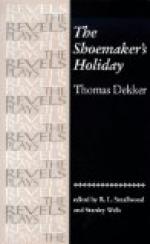|
This section contains 6,568 words (approx. 22 pages at 300 words per page) |

|
SOURCE: “The End(s) of Discord in The Shoemaker's Holiday,” in Studies in English Literature 1500-1900, Vol. 36, No. 2, Spring 1996, pp. 357-72.
In this essay, Straznicky asserts that The Shoemaker's Holiday “enacts an imaginary appropriation of civic authority and commercial wealth by a group of industrial laborers for whom both privileges were largely a matter of fantasy.”
The Shoemaker's Holiday (1599) is one of only three Elizabethan comedies named after specific festive occasions.1 While most critics have duly noted the importance of the festival to the play's structural and thematic design, their accounts employ a vague and moralistic vocabulary that is strangely out of keeping with the concrete, even materialistic language of the play itself. Michael Manheim, for example, sees the Guildhall feast as a “victory for the forces of humility and good will,” and Arthur Kinney calls it “the still centre where passion and reason are themselves advanced, but...
|
This section contains 6,568 words (approx. 22 pages at 300 words per page) |

|


